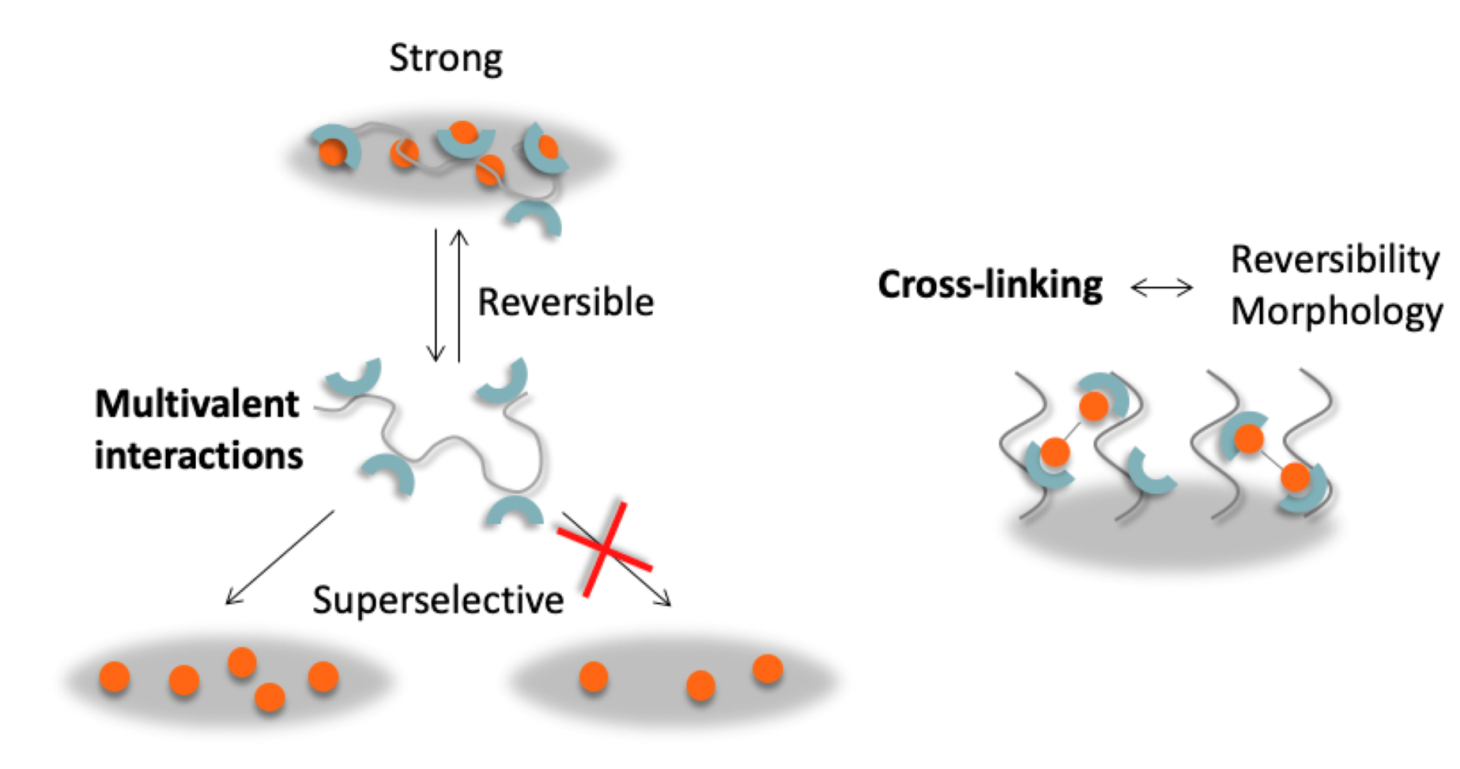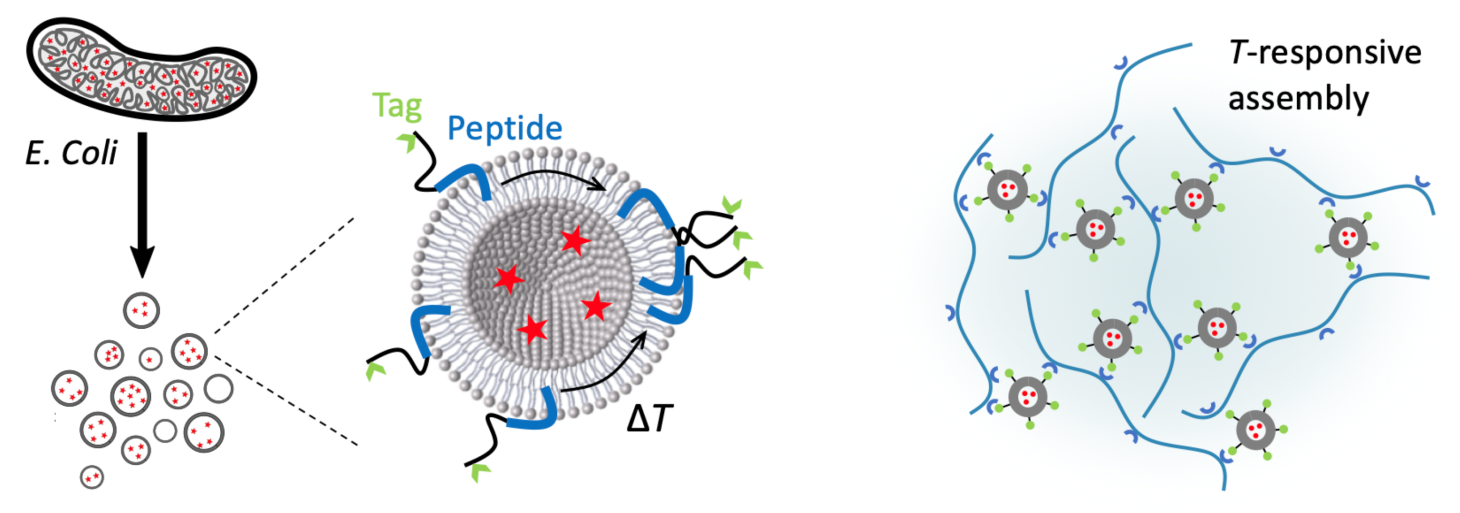- Imprimer
- Partager
- Partager sur Facebook
- Partager sur X
- Partager sur LinkedIn
- Dynamic fluorescent nanostructures
Galina Dubacheva
Didier Boturyn
Liliane Guerente
Hugues Bonnet
Rémy Lartia

One of the current challenges of applied plasmonics is to control molecular configuration around nanostructures as a promising route to drive their functionality. Recently, we showed that fluorescence can be reversibly switched by modulating the Au NP/fluorophore distance using thermo-responsive polymers (Kamzabek et al, Langmuir, 2021, 37, 10971–10978). Currently, we extend this strategy to other stimuli-responsive interactions like host/guest complexes, for which our team has established synthetic and surface chemistry approaches. This concept is compatible with nanostructured surfaces, which we characterize using fluorescence, electrochemistry, AFM, QCM-D and their in-situ coupling. This approach allows several advantages, including reversible modulation of fluorescence, various external stimuli and compatibility with surface confinement, which should extend potential applications of dynamic plasmonics in diagnostic and sensing assays. From the fundamental point of view, we investigate how surface chemistry and surface confinement influence supramolecular assemblies, including multivalent interactions which are common in biological systems (Dubacheva et al, Acc. Chem. Res. 2023, 56, 729-739).
This project is supported by the ANR JCJC SupraSwitch (“Hybrid supramolecular/plasmonic switches as luminescence sensors and watermarkers”, 2020-2025) and Labex Arcane Tickets TRNanoBio ("Thermoresponsive nano-assemblies for multifunctional bio-analysis", 2023-2024) fundings. Motivated students interested to participate in this project, please contact galina.dubacheva univ-grenoble-alpes.fr (galina[dot]dubacheva[at]univ-grenoble-alpes[dot]fr).
univ-grenoble-alpes.fr (galina[dot]dubacheva[at]univ-grenoble-alpes[dot]fr).
Collaborations:
R. Auzély (CERMAV, Grenoble)
R. Richter (University of Leeds, UK)
F. Miomandre (ENS Paris-Saclay)
- Multivalent cross-linking of polymer brushes
Project Staff
Galina Dubacheva
Didier Boturyn
Liliane Guerente
Hugues Bonnet

Our studies showed that multivalent binding to surfaces provides several advantages such as the combination of strong adhesion and reversibility (Dubacheva et al, Langmuir 2010, 26, 13976-13986; Dubacheva et al, Chem. Commun. 2011, 47, 3565-3567) and superselectivity, i.e. the ability to sharply discriminate between small differences in the density of surface binders (Dubacheva et al, Acc. Chem. Res. 2023, 56, 729-739). As a step forward, we propose to study multivalent interactions at more complex interfaces such as polymer brushes. We aim to design well-defined model systems allowing to quantify the ensemble of physico-chemical characteristics of polymer brushes exposed to soluble cross-linkers at tunable valency and affinity. Such study will provide insights on how multivalent interactions between polymer brushes and their soluble crosslinkers regulate the resulting supramolecular structure and dynamics in biological systems (e.g. hyaluronan and its binding proteins) and provide cues for the design of polymer brushes with tunable properties (e.g. permeability, repelling) for advanced applications in sensing or biomimetic systems.
This project is supported by the IRB UGA ResPoNSE funding (“Stimuli-responsive polymer brushes: novel model surfaces elaboration”, 2023-2024). Motivated students interested to participate in this project, please contact galina.dubacheva univ-grenoble-alpes.fr (galina[dot]dubacheva[at]univ-grenoble-alpes[dot]fr).
univ-grenoble-alpes.fr (galina[dot]dubacheva[at]univ-grenoble-alpes[dot]fr).
Collaborations:
R. Richter (University of Leeds, UK)
R. Auzély (CERMAV, Grenoble)
- Thermo-responsive liposomes
Project Staff
Galina Dubacheva
Angéline Van der Heyden
Hugues Bonnet

Using our expertise in the design of well-defined interfaces and physico-chemical characterization of stimuli-responsive interactions in solution (DLS, fluorescence) and on surfaces (QCM-D, ellipsometry), we contribute to different projects involving thermo-responsive supramolecular assemblies. Our collaboration with the group of C. Tribet, ENS Paris (ANR PRC GenCaps, “Bacterial-based production of Genetically Encoded Responsive Capsules” 2018-2022) enabled the development of multifunctional vesicles, which are monodisperse size, can be loaded with functional proteins and display dense array of transmembrane peptides allowing post-functionalization (Royes et al, Angew. Chem. Int. Ed. 2019, 131, 7473-7477). Integration of thermo-responsive sequences in these functional vesicles is under investigation to assess their use for drug release and targeting applications. Recently, we started collaboration with the group of R. Auzély (CERMAV, Grenoble) on the development of self-healing hydrogels based on thermo-responsive liposomes, which has been supported by the ANR PRC grant UtHeal funding ("Ultrasound-triggered disruption and self-healing of hydrogels for on-demand and repeated cargo release", 2024-27). Motivated students interested to participate in this project, please contact galina.dubacheva univ-grenoble-alpes.fr (galina[dot]dubacheva[at]univ-grenoble-alpes[dot]fr) (master and research engineer positions are open in our team starting from 01/01/2024).
univ-grenoble-alpes.fr (galina[dot]dubacheva[at]univ-grenoble-alpes[dot]fr) (master and research engineer positions are open in our team starting from 01/01/2024).
Collaborations:
R. Auzély (CERMAV, Grenoble)
C. Tribet (ENS Paris)
Project Staff
- Imprimer
- Partager
- Partager sur Facebook
- Partager sur X
- Partager sur LinkedIn